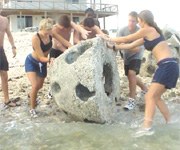Reef Balls
Animals in the sea often compete for space. Corals and other
animals that attach to hard surfaces need to find an open space to grow. Fish
also need places to hide from predators. Artificial reefs create habitat for
fish, coral, algae, and sponges. People have used all sorts of materials to make
artificial reefs, from old ships and tanks, to blocks of concrete. BREEF decided
in 2000 to purchase equipment to make Reef Balls, a specific type of artificial
reef made out of concrete, and donate them to The Island School.

Reef Ball
Development Company invented Reef Balls, and designed a system for making
these hollowed-out igloos of concrete that resist storm waves, have a surface
that allows corals to settle and grow, and have caverns that allow fish spaces
to hide. Since 2000, students at The Island School have made over 50 reef balls
and are studying which plants and animals colonize the artificial reefs.
Since then Island School students have reported seeing
wrasses, grunts, groupers, doctor fish, snappers, butterfly fish, and many other
species of fish on the reef balls. Students have placed reef balls close to
natural reefs, far from natural reefs, on sandy bottom, on grassy bottom
surfaces, and added halo structures of PVC to try and make the artificial reefs
more attractive to sea creatures.

Students are placing reef balls in groups around the coast of
The Island School, in an effort to prevent erosion of the soil around the coast.
There is lots of water moving back and forth across the peninsula of The Island
School, and waves and wind also tend to carry away sediment. Over time (and
especially during storms) The Island School is losing land out to sea. So reef
balls might not just be useful for attracting fish; they might also slow the
rate of soil loss.
The teachers in the BREEF 4 workshop built their own Reef Ball
on San Salvador. By getting their hands dirty and putting their back into it,
BREEF workshop teachers are making an investment in the ocean. So many of the
ways that humans can help the marine environment are by not doing something: not
fishing undersized grouper, not spearing on scuba, not throwing an anchor on the
reef, not touching corals with hands or fins, not taking juvenile conchs, not
taking crawfish with eggs (berries). But it feels good to do something active to
help the fish. Building a reef ball is one of the ways to connect teachers and
their students to their role in protecting those good things in the sea that no
one wants to see disappear.
<Back





